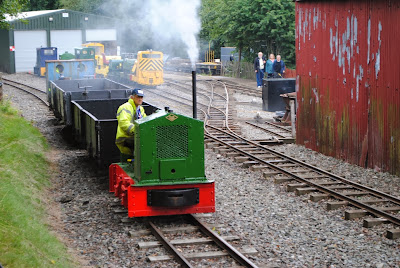I think this was first visit to the Vale of Rheidol since the days of blue engines marked with the devil's footprint.
Big things are afoot. There is a new 200-foot three road workshop being fitted out at Aberystwyth. Every intermediate station apart from Llanbadarn (which effectively no longer exists) has a new platform and waiting shelter. Tree clearance has opened up some views. Devil's Bridge station will be getting a platform and a large museum building is to be erected at Aberystwyth using part of the trainshed from the old London Bridge Station, hopefully in association with a station redevelopment.
 |
| The new workshops |
 |
| Shelter being painted at Nantyronen |
 |
| Completed shelter and fencing at Rheidol Falls |
 |
The only item I saw of the 'Rampton Collection' was this
Colonial Sugar Refining bogie tender from Fiji at Capel Bangor |
To be fair, some features of the old basic tourist railway, some of which must date back to GWR days, are still current. The carriages, beautiful externally, are somewhat spartan internally, which heightens the sense of crowding when the train is full. It was a cold windy day and the first train had five cars including an open carriage. On its return, crowds appeared from nowhere for the afternoon service so two additional carriages were added (to what appears to be the maximum that can be handled at Devil's Bridge without a pilot engine there). One of the two additional carriages was an open car, which seemed unnecessary and was little appreciated by the passengers. So I felt that a little of the 'cattle class' feeling remains. Hopefully the money being spent elsewhere will be followed by improvements for on-train passengers also.
Only two of the line's three steam locomotives are in use. OWAIN GLYND
ŴR is a chassis sitting on a wagon at the station. However, it must be said that the external presentation of the trains is excellent and the dramatic nature of the line is second to none.
 |
PRINCE OF WALES at Aberystwyth.
Surely there must be no doubt that it was built by the GWR in 1924. |
 |
| OWAIN GLYNDŴR |
 |
| Carriages beautifully presented |
 |
| . . . but rather 'tourist class' inside. Is this 'heritage' to be retained? |
 |
| Inside the old BR shed at Aberystwyth |
 |
| Permaquip navvy car at Capel Bangor |
 |
| On arrival at Devil's Bridge |
 |
| Running around |
 |
Pilot at Aberystwyth
Baguley-Drewry type of 1987 built at Brecon Mountain Railway
|





























































